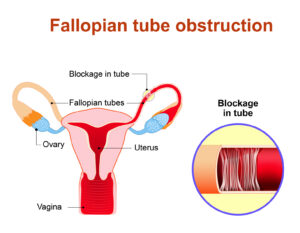Hydrosalpinx (Blocked Fallopian Tube)

Hydrosalpinx at a glance
- Hydrosalpinx is the condition in which the end portion of a woman’s fallopian tube becomes fluid-filled and swollen, which can cause infertility.
- The swelling and blockage most often occur at the end of the fallopian tube where it connects to the ovary (called the fimbrial end), preventing the ovulated egg from entering the fallopian tube where it is normally fertilized by the sperm.
- Hydrosalpinx, a form of tubal factor infertility, can be caused by pelvic infections (including chlamydia), pelvic surgery, endometriosis, adhesions and some tumors.
- Often there are no symptoms but primary symptoms that do present are pelvic pain and infertility.
- Hydrosalpinx is usually treated by a minimally invasive surgery called salpingostomy that unblocks the fallopian tube.
- If surgical treatment does not restore fertility, in vitro fertilization (IVF) can bypass the need for the fallopian tube to achieve pregnancy.
What is hydrosalpinx?
Hydrosalpinx is the blockage of a woman’s fallopian tube caused by a fluid buildup and dilation of the tube at its end. Most often it occurs at the fimbrial end of the tube next to the ovary, but it can also occur at the other end of the tube that attaches to the uterus. The term hydrosalpinx comes from Greek, with hydro meaning water and salpinx meaning tube.
Blocked fallopian tubes are one form of tubal factor infertility. When the fallopian tube is blocked, the cells inside the tube secret fluid that can’t escape, dilating the tube. This prevents fertilization – and thus pregnancy – by blocking an ovulated egg from moving from the ovary to the fallopian tube for fertilization by the sperm. If an ovulated egg is somehow able to connect with a sperm for fertilization, the hydrosalpinx would still likely block the resulting embryo from traveling to the uterus for implantation and pregnancy. It can also potentially cause a dangerous ectopic pregnancy, in which the embryo implants outside the uterus, most often inside the fallopian tube, and results in a life-threatening situation.
When hydrosalpinx is present in one of the fallopian tubes, it is often common in the other one as well, known as bilateral hydrosalpinx.
Hydrosalpinx can also negatively impact fertility treatment. According to the National Institutes of Health, when hydrosalpinx fluid is present in a woman undergoing assisted reproductive technologies such as IVF, it reduces the success of such treatments by half compared with woman who do not have hydrosalpinx. For this reason, women wanting to conceive via IVF are often counseled to have the hydrosalpinx surgically removed before IVF treatment.
In addition, the presence of hydrosalpinx appears to have a bearing on successful pregnancy if the woman does get pregnant (either naturally or through fertility treatment). Scientists are not sure why this is the case but suspect that hydrosalpinx causes embryo and egg toxicity and affects the endometrium in ways that result in poor embryo implantation and growth.
RadioMD “Fertility Talk” Podcasts
Dr. William Ziegler discusses symptoms, causes and fertility treatment for hydrosalpinx, commonly called blocked fallopian tubes.
HydrosalpinxCauses & symptoms of hydrosalpinx
Previous infections, the most common being chlamydia (a sexually transmitted disease), can cause hydrosalpinx. Previous surgery in the pelvic area, particularly of the fallopian tubes themselves, can also be the cause. Other causes of blocked fallopian tubes include endometriosis, adhesions in the pelvic region, some tumors and other infections, such as from appendicitis or pelvic inflammatory disease.
Most women don’t notice any symptoms, except for the inability to get pregnant. Others may experience pain in their pelvis or lower abdomen, or have a discolored or sticky vaginal discharge. An ectopic pregnancy is an indication that hydrosalpinx may be present.
Diagnosis & treatment of hydrosalpinx
Doctors most often use a hysterosalpingogram to diagnose hydrosalpinx. This is an X-ray type of evaluation of the fallopian tube using a thin catheter inserted through the cervix and uterus to inject a dye that reveals the outline of the fallopian tube. A series of X-ray images shows the filling of the fallopian tubes, revealing to the physician whether the fallopian tubes are blocked.
Doctors may also be able to see that the fallopian tube is enlarged using an ultrasound imaging test. Laparoscopy surgery, in which a small tube with a camera is inserted through small incisions in the belly, allows the surgeon to administer dye that can show if the fallopian tube is blocked by hydrosalpinx.
Surgical correction
Using minimally invasive surgery known as salpingostomy, surgeons can remove the damaged and enlarged areas of the fallopian tube by cutting them off and taking them out. They can also reopen the sealed end of the fallopian tube. Removing the tube entirely is also an option, which is called a salpingectomy. IVF is required for pregnancy after salpingectomy.
Surgeons may also clip or burn the affected ends of the tubes and leave the tube in place prior to IVF.
As with any surgery, these procedures carry risks including reaction to anesthesia, blood loss, scarring, tissue damage and pain. Women should discuss all surgical options’ risks and benefits with their physician.

